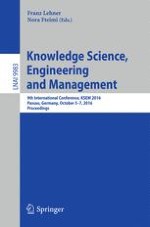This book constitutes the refereed proceedings of the 9th International Conference on Knowledge Science, Engineering and Management, KSEM 2016, held in Passau, Germany, in October 2016.
The 49 revised full papers presented together with 2 keynotes were carefully selected and reviewed from 116 submissions. The papers are organized in topical sections on Clustering and Classification; Text Mining and Lexical Analysis; Content and Document Analysis; Enterprise Knowledge; Formal Semantics and Fuzzy Logic; Knowledge Engineering; Knowledge Enrichment and Visualization; Knowledge Management; Knowledge Retrieval; Knowledge Systems and Security; Neural Networks and Artificial Intelligence; Ontologies; and Recommendation Algorithms and Systems.
